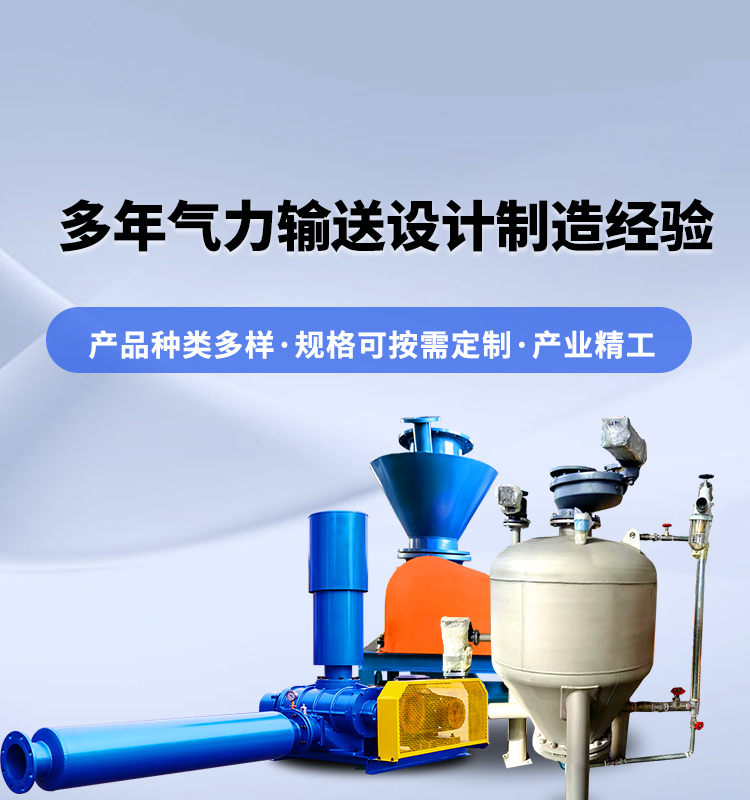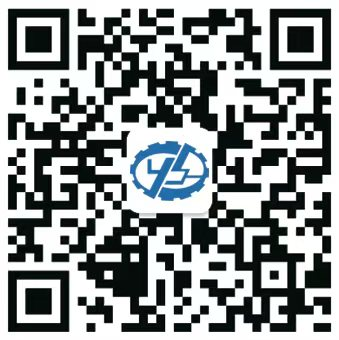氣力輸送系統憑借高效、密閉、占地小等優勢,在工業物料輸送中占據重要地位。然而,并非所有物料都適合采用這種輸送方式,其對物料的物理特性、化學性質及狀態有著明確要求,這些要求直接影響系統的運行效率、穩定性及安全性。
Pneumatic conveying systems play an important role in industrial material conveying due to their advantages of high efficiency, airtightness, and small footprint. However, not all materials are suitable for this conveying method, as it has clear requirements for the physical properties, chemical properties, and state of the materials, which directly affect the operational efficiency, stability, and safety of the system.
物料的粒度與粒徑分布是首要考量因素。一般來說,氣力輸送系統更適合處理粒徑在 0.1 微米至 50 毫米之間的物料。粒徑過小(如小于 1 微米的超細粉體)容易因氣流擾動形成團聚,導致管道堵塞,且可能穿透濾袋造成環境污染;粒徑過大(如超過 50 毫米的塊狀物料)則需要更高的氣流速度才能攜帶,不僅增加能耗,還會加劇管道磨損,縮短設備使用壽命。對于顆粒狀物料,粒徑分布應相對均勻,若粗細顆粒混雜比例過高,細顆粒可能填充粗顆粒間隙,降低物料流動性,影響輸送效率。例如,糧食加工中輸送的小麥、玉米,粒徑多在 2-5 毫米,分布均勻,適合氣力輸送;而含有大量泥沙的礦石碎料,因粒徑差異大,需先篩分處理后再輸送。
The particle size and particle size distribution of the material are the primary considerations. Generally speaking, pneumatic conveying systems are more suitable for processing materials with particle sizes between 0.1 micrometers and 50 millimeters. Particle sizes that are too small (such as ultrafine powders smaller than 1 micron) are prone to agglomeration due to airflow disturbances, leading to pipeline blockages and potentially penetrating filter bags and causing environmental pollution; If the particle size is too large (such as block materials exceeding 50 millimeters), a higher airflow velocity is required to carry them, which not only increases energy consumption, but also exacerbates pipeline wear and shortens equipment service life. For granular materials, the particle size distribution should be relatively uniform. If the mixing ratio of coarse and fine particles is too high, fine particles may fill the gaps between coarse particles, reduce material fluidity, and affect conveying efficiency. For example, wheat and corn transported in grain processing have a particle size of 2-5 millimeters, evenly distributed, and suitable for pneumatic conveying; And the ore fragments containing a large amount of sediment need to be screened and processed before transportation due to the large difference in particle size.

物料的密度與堆積特性影響輸送能耗與穩定性。通常,堆積密度在 0.2-2.0 噸 / 立方米的物料更適合氣力輸送。密度過小(如輕質泡沫顆粒)易被氣流過度攜帶,導致分離困難;密度過大(如金屬粉末)則需要更高的氣流壓力,能耗顯著增加,且在輸送過程中易因重力沉降造成管道堵塞。物料的堆積角(自然堆積時的傾斜角度)也需關注,堆積角小于 30° 的物料(如石英砂)流動性好,不易堵塞管道;堆積角大于 45° 的物料(如潮濕的煤粉)流動性差,易在管道彎頭、閥門處滯留,需通過添加流化裝置改善流動性。此外,物料的安息角需與輸送速度匹配,安息角大的物料需要更高的氣流速度才能保持懸浮狀態。
The density and stacking characteristics of materials affect the energy consumption and stability of transportation. Generally, materials with a bulk density of 0.2-2.0 tons/cubic meter are more suitable for pneumatic conveying. If the density is too small (such as light foam particles), it is easy to be carried by the airflow, resulting in difficult separation; If the density is too high (such as metal powder), it requires higher airflow pressure, significantly increases energy consumption, and is prone to pipeline blockage due to gravity settling during transportation. The stacking angle of materials (the inclination angle during natural stacking) should also be taken into account. Materials with a stacking angle less than 30 ° (such as quartz sand) have good flowability and are less likely to block pipelines; Materials with a stacking angle greater than 45 ° (such as wet coal powder) have poor flowability and are prone to retention at pipeline bends and valves. It is necessary to improve flowability by adding fluidization devices. In addition, the resting angle of the material needs to match the conveying speed, and materials with a larger resting angle require higher airflow velocity to maintain a suspended state.
物料的濕度與粘性是影響輸送順暢性的關鍵。一般要求物料的含水率低于 10%,過高的濕度會使物料結塊、粘連,附著在管道內壁和設備部件上,逐漸縮小管道截面,最終導致堵塞。例如,潮濕的粉煤灰若直接采用氣力輸送,會在管道內形成 “泥餅”,不僅阻礙物料流動,還會腐蝕管道。對于必須輸送的濕料,需先進行干燥處理,或在系統中設置加熱裝置防止水分凝結。粘性物料(如樹脂顆粒、麥芽糖粉)即使含水率較低,也可能因分子間作用力相互粘連,需在輸送前添加抗粘劑,或選用內壁光滑的耐磨管道(如陶瓷內襯管道),減少物料附著。
The humidity and viscosity of materials are key factors affecting the smoothness of transportation. Generally, it is required that the moisture content of the material be below 10%. Excessive humidity can cause the material to clump and adhere to the inner wall of the pipeline and equipment components, gradually reducing the cross-section of the pipeline and ultimately leading to blockage. For example, if wet fly ash is directly transported by pneumatic conveying, it will form a "mud cake" inside the pipeline, which not only hinders the flow of materials but also corrodes the pipeline. For wet materials that must be transported, drying treatment should be carried out first, or heating devices should be installed in the system to prevent moisture condensation. Viscous materials (such as resin particles and maltose powder) may adhere to each other due to intermolecular forces even if their moisture content is low. It is necessary to add anti adhesive agents before transportation or use wear-resistant pipes with smooth inner walls (such as ceramic lined pipes) to reduce material adhesion.
物料的化學性質決定系統的材質選擇與安全防護。易氧化的物料(如鐵粉、鋁粉)在輸送過程中需控制氧氣含量,可采用惰性氣體(如氮氣)作為輸送介質,防止氧化燃燒;具有腐蝕性的物料(如酸堿鹽粉體)需選用耐腐材質的管道與設備(如不銹鋼、聚四氟乙烯材質),避免因物料與設備反應導致泄漏。易燃易爆物料(如煤粉、硫磺粉)對輸送環境要求嚴格,系統需采用防爆電機、防靜電管道,且輸送速度需控制在安全范圍內(通常低于 20 米 / 秒),防止物料與管道摩擦產生靜電火花引發爆炸。此外,食品、醫藥行業輸送的物料需符合衛生標準,系統材質需無毒、易清潔,避免物料污染,如輸送面粉、藥用輔料時,管道內壁需拋光處理,防止微生物滋生。
The chemical properties of materials determine the material selection and safety protection of the system. Materials that are prone to oxidation (such as iron powder and aluminum powder) need to control their oxygen content during transportation. Inert gases (such as nitrogen) can be used as the conveying medium to prevent oxidation and combustion; Corrosive materials (such as acid and alkali salt powders) should be used for pipelines and equipment made of corrosion-resistant materials (such as stainless steel and polytetrafluoroethylene) to avoid leakage caused by reactions between materials and equipment. Flammable and explosive materials (such as coal powder and sulfur powder) have strict requirements for the conveying environment. The system needs to use explosion-proof motors and anti-static pipelines, and the conveying speed needs to be controlled within a safe range (usually less than 20 meters per second) to prevent static sparks caused by friction between materials and pipelines from causing explosions. In addition, materials transported in the food and pharmaceutical industries must comply with hygiene standards, and the system materials must be non-toxic, easy to clean, and avoid material contamination. For example, when transporting flour and medicinal excipients, the inner walls of the pipelines need to be polished to prevent microbial growth.
本文由氣力輸送系統友情奉獻.更多有關的知識請點擊:http://m.szbzt.cn/我們將會對您提出的疑問進行詳細的解答,歡迎您登錄網站留言.
This article is dedicated to friendship For more information, please click: We will provide detailed answers to your questions. You are welcome to log in to our website and leave a message
聯系電話
二維碼
